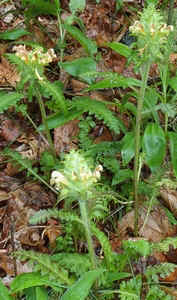 |
Common Name: Wood Betony, Lousewort
Scientific Name: Pedicularis canadensis
Family: Scrophulariaceae
Blue Ridge Parkway
North Carolina
May 9, 2002
 |
Perennial, pubescent herbs, usually 6-12 inches tall, with yellow or yellow and red flowers in a compact spike 1 inch or more in diameter. The fern-like leaves of the flowering stalk are alternate. Relatively infrequent in moist, deciduous woodlands and piedmont of North Carolina, Wood Betony is native to the eastern U.S. A fall flowering species, P. lanceolata, with opposite stem leaves, occurs in our southwestern mountains. May-July [Justice, William S. and Bell, C. Ritchie, Wild Flowers of North Carolina. University of North Carolina Press, Chapel Hill, 1968]
Clustered together at the apex of a thick, hairy stem are divided leaves and colorful flowers. The alternate leaves are so finely cut that they are often mistaken for ferns. The flowers are surprisingly beautiful. Each bloom is composed of two lips, The upper red lip is divided into two lobes which curve above the lower, three-toothed, yellow lip. These form a tight tube housing the reproductive organs. Some believe that because of a relationship with a fungus, this plant will not grow well outside its natural habitat. Folklore has saddled this beautiful blossom with an ugly name, lousewort. Farmers erroneously thought it causes lice in their cattle. Even the genus, Pedicularis, means "of the lice." April-June [White, Peter, Wildflowers of the Smokies. Great Smoky Mountains Natural History Association, Gatlinburg, 1996]
The flowers of lousewort may be yellow, red, or a combination of both colors. They are hooded, with a tri-lobed lower lip, and grow in a short, dense spike. The leaves are fernlike, deeply lobed, and arranged alternately. The 6- to 18-inch stem is densely hairy. Although this herb is somewhat scruffy and unusual in appearance, it certainly doesn't deserve a name as undignified as lousewort. Apparently it comes from a misbelief that animals who graze the plant will soon be covered with lice. Wood betony is a kinder name. Indians used the ground roots of lousewort as aphrodisiacs. Today it is used in the treatment of Bell's palsy, a disease that affects facial nerves. April-July [Adams, Kevin and Casstevens, Marty, Wildflowers of the Southern Appalachians: How to Photograph and Identify Them. John F. Blair, Publisher, Winston-Salem, 1996]
January February March April May June July August September October November December
Alphabetical Listings -- A B C D, E F G H I, J, K L M N, O P Q, R S T U, V W X, Y, Z
Family Listings -- A B C D, E F G H I, J, K L M N, O P Q, R S T U, V W X, Y, Z
Genus Listings -- A B C D, E F G H I, J, K L M N, O P Q, R S T U, V W X, Y, Z